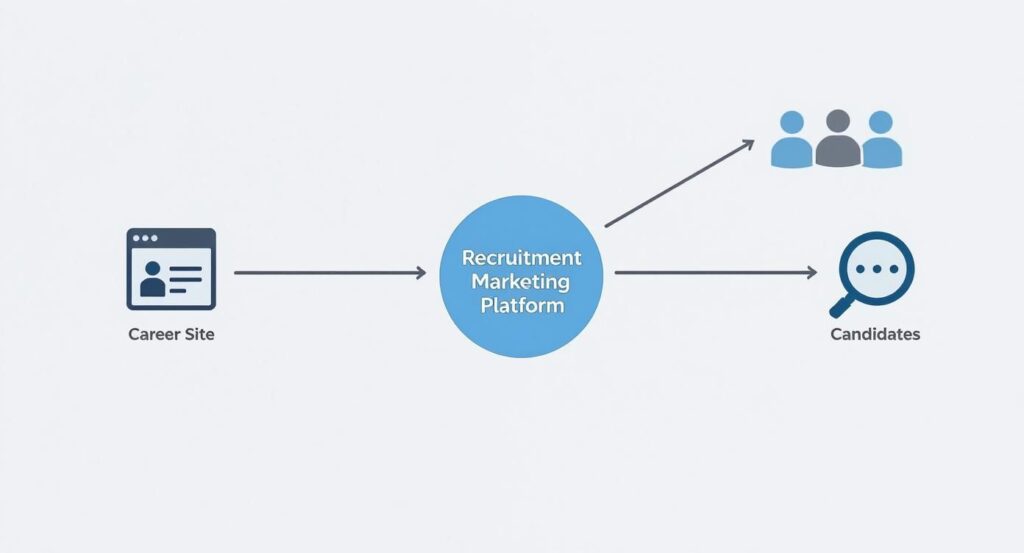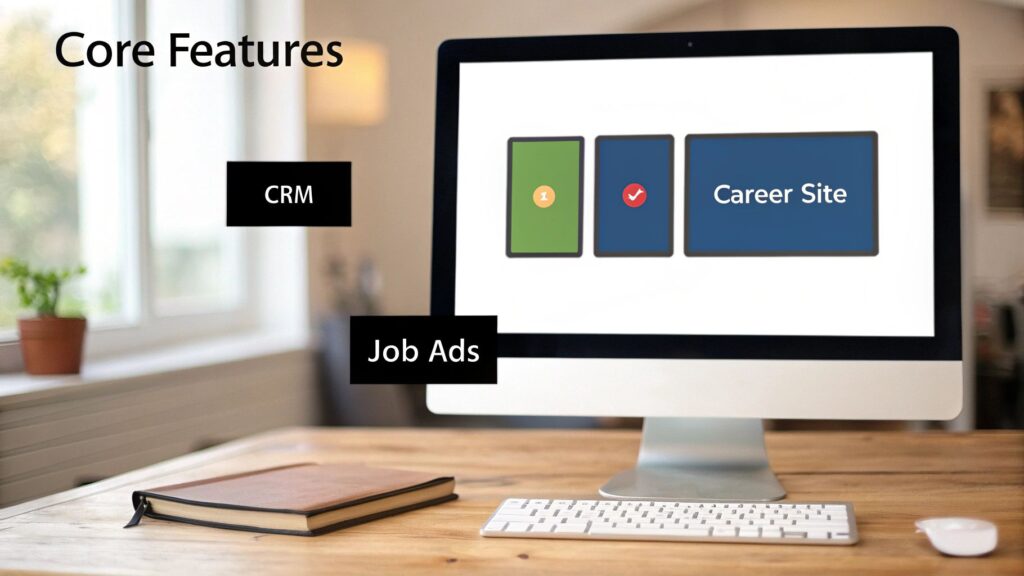A recruitment marketing platform is a centralised piece of software that fundamentally changes how companies find talent. It helps you proactively attract, engage, and nurture the right people for your organisation. Essentially, it applies proven marketing principles to the hiring process, shifting your focus from just filling empty seats to building a steady pipeline of qualified candidates.
What Is a Recruitment Marketing Platform
Think about the old way of hiring. It was a bit like fishing with a single line and waiting for a bite. You’d post a job opening and just hope the right person happened to see it and apply. It was a reactive, often slow process.
A recruitment marketing platform completely flips that script. It’s like setting up a modern, automated fishing operation. You have multiple nets in the water (job boards, social media, your career site), you’re using targeted bait (personalised content), and you have a system to keep track of every potential “fish” in your pond.
This proactive approach changes the entire dynamic of how you connect with potential employees. Instead of viewing people as just applicants for one specific job, the platform helps you build long-term relationships with a community of talent.
Unifying the Hiring Funnel
One of the biggest wins of a recruitment marketing platform is that it breaks down the silos that often exist between different hiring tools. It pulls everything—from your career site and social media campaigns to your candidate databases—into one cohesive hub. This ensures every potential candidate gets a consistent, positive message from your brand.
This infographic paints a clear picture of how it all connects.

As you can see, the platform really does act as a command centre, letting you coordinate your entire talent attraction strategy from one place.
The Shift to Proactive Talent Attraction
In today’s fierce talent market, companies can’t afford to stick with the old “post and pray” method. To win, you have to get proactive. This means:
- Building Talent Pools: This is about creating communities of skilled people who are interested in your company, even if you don’t have the perfect role for them right now.
- Nurturing Leads: You need to keep these potential candidates engaged. A platform helps you do this by sending personalised content, company updates, and relevant job alerts to keep your company top-of-mind.
- Enhancing Employer Brand: Your brand is your magnet. A platform allows you to consistently showcase your company culture and values across every channel, attracting passive candidates who are a great fit for your mission.
By bringing marketing automation and sharp analytics into the hiring game, these platforms free up recruiters to be strategic talent advisors. They can focus on building meaningful relationships instead of just processing applications. You can explore our insights on how such a platform eases digital hiring to see the practical benefits.
The move towards this technology is picking up serious steam. In India, the recruitment software market hit USD 80 million in 2024 and is expected to climb to USD 120 million by 2033, with AI and automation leading the charge. This growth isn’t just a number; it shows a fundamental shift in how smart companies are approaching talent acquisition.
Recruitment Marketing Platforms vs Traditional ATS
It’s easy to confuse a recruitment marketing platform with a standard Applicant Tracking System (ATS), but they serve very different purposes. An ATS is reactive—it manages people who have already applied. A recruitment marketing platform is proactive—it finds and engages people before they even apply.
Here’s a simple breakdown of the key differences:
| Capability | Recruitment Marketing Platform (Proactive) | Traditional ATS (Reactive) |
|---|---|---|
| Primary Focus | Attracting & engaging passive/active talent (Top of Funnel) | Managing active applicants (Mid/Bottom of Funnel) |
| Candidate Source | Job boards, social media, email campaigns, talent pools | Direct applications to specific job postings |
| Communication | Personalised, automated nurturing campaigns | Standardised, transactional emails (e.g., application received) |
| Core Function | Building talent pipelines and employer brand | Processing and tracking applications for open roles |
| Analytics | Measures source effectiveness, engagement, brand reach | Measures time-to-fill, cost-per-hire, application volume |
Essentially, the recruitment marketing platform feeds a pipeline of warm, qualified candidates into the ATS. They work best when used together, creating a powerful, end-to-end hiring machine.
The Core Features That Power Modern Hiring
To really get what a recruitment marketing platform can do, you need to look past a simple feature list. Don’t think of it as a toolbox. It’s more like an integrated engine, where every part works in sync to pull in and nurture great talent. These features change hiring from a bunch of separate tasks into one smooth, strategic operation.
The heart of this engine is the Candidate Relationship Management (CRM) feature. This is where proactive recruiting really comes to life. A CRM lets you build and manage talent communities—groups of potential hires who are keen on your company, even if the perfect role for them doesn’t exist today.
Think about this scenario: you had a fantastic candidate who was the runner-up for a key role. In the old way of doing things, their details might just get lost in a spreadsheet somewhere. With a CRM, this “silver medallist” gets tagged and put into a specific talent pool. Six months down the line, when a similar job opens up, you can instantly get back in touch with a personalised message. Just like that, you’ve slashed your sourcing time and costs.

Building Your Digital Front Door
For many candidates, your career site is the very first real interaction they have with your employer brand. A recruitment marketing platform comes with a dynamic career site builder, which allows you to create a compelling, on-brand experience without needing a whole team of developers.
This is about much more than just listing job openings. It’s your chance to show off your company culture with employee stories, videos, and clear statements about what you stand for. A well-built career site acts as your digital front door, welcoming candidates in and making it simple for them to find roles that are a great match for their skills and passions.
Amplifying Your Reach Intelligently
Once you’ve got a brilliant career site, you need to get the right people to see it. That’s where job distribution and programmatic advertising tools step in. Instead of you having to manually post jobs on different boards, the platform handles it all for you automatically.
Programmatic advertising is even smarter. It uses data and algorithms to automatically place your job ads on the websites where your ideal candidates are most likely to hang out, all while optimising your budget in real-time. This makes sure your recruitment spend is going to the channels that actually deliver results, not just the ones everyone uses.
The main idea is simple but incredibly powerful: create a seamless journey. A candidate might first see your company through a programmatic ad, then get a feel for your culture on the career site, and finally join your talent community through the CRM—all managed by one intelligent recruitment marketing platform.
Automating Engagement and Nurturing Talent
Trying to keep in touch with hundreds or thousands of potential candidates manually is just not possible. That’s why email and SMS marketing automation is a crucial feature. It lets you set up automated “drip campaigns” that send targeted content to different groups within your talent pool.
Here’s a quick look at how it works:
- New Subscribers: When someone new joins your talent community, they could automatically get a welcome email series that introduces them to your company’s mission and values.
- Past Applicants: Candidates who previously applied for tech jobs might get a monthly newsletter that highlights your latest engineering projects and breakthroughs.
- Event Attendees: People your team met at a campus hiring event could receive targeted messages about your early career opportunities.
This kind of automated nurturing keeps your brand at the front of their minds. So, when the perfect role does open up, you already have a warm pipeline of engaged candidates who are ready to apply.
The integration of artificial intelligence is making these tools even more powerful. The AI recruitment market in India is projected to grow from USD 43.2 million in 2024 to USD 90.6 million by 2035, a surge driven by the demand for more efficient talent acquisition. AI is improving everything from matching candidates to jobs to providing predictive analytics, which frees up recruiters to focus on what they do best: making human connections. Discover more insights about the AI recruitment market in India on marketresearchfuture.com. Together, these features create a hiring engine that isn’t just efficient but is also deeply focused on building lasting relationships with top talent.
What’s in It for Your Organisation?
Bringing a recruitment marketing platform into your toolkit isn’t just about adopting new software; it’s a strategic decision with real, bottom-line impact. The features we’ve talked about aren’t just abstract concepts—they translate directly into measurable wins that leadership will notice. These advantages ripple across the entire talent acquisition journey, from the first hello to the final handshake.
Think about the most immediate payoff: the candidate experience. Nothing turns off top talent faster than a clunky, impersonal application process. A recruitment marketing platform flips that script, creating a smooth and engaging journey that shows you respect a candidate’s time and interest.
This better experience naturally leads to higher application completion rates. When candidates feel valued and the process is a breeze, they’re far more likely to stick with it, which instantly widens your pool of potential hires.
Strengthen Your Employer Brand and Attract Passive Talent
Your employer brand is your most powerful magnet for talent. It’s the story you tell about your company’s culture, your values, and your mission. A recruitment marketing platform acts as your central storyteller, ensuring that narrative is consistent across your careers site, social media channels, and email outreach.
This consistency is absolutely vital for catching the eye of passive candidates—those skilled professionals who aren’t actively job hunting but are always open to a great opportunity. By showcasing a dynamic workplace and a clear purpose, you plant a seed. When a role that fits their profile eventually opens up, your organisation is already on their radar as a top place to work.
This is a mindset shift from reactive hiring to proactive talent attraction. You’re not just filling an open role; you’re building a reputation that consistently draws in high-calibre people.
Free Up Your Recruiters with Smart Automation
Your recruitment team’s superpower is building relationships. Too often, though, they’re bogged down by repetitive, administrative busywork. A recruitment marketing platform automates many of these low-value tasks, freeing them up to focus on what actually moves the needle.
Just think about the hours spent manually posting jobs, sending generic follow-up emails, or wrestling with spreadsheets to track candidate conversations. Automation takes care of all that, letting your team spend more quality time on high-impact activities like:
- Building Genuine Connections: Engaging one-on-one with the best prospects in your talent pipeline.
- Strategic Sourcing: Proactively identifying and connecting with talent for future, hard-to-fill roles.
- Advising Hiring Managers: Serving as true talent consultants to the business.
By automating the routine, you empower your recruiters to be more strategic. This not only makes them more productive but also boosts their job satisfaction—a key ingredient in retaining your own top talent acquisition pros.
Lower Your Cost-Per-Hire with Data-Driven Insights
Making budget decisions without good data is just guesswork. A recruitment marketing platform gives you a single analytics dashboard that shows you exactly which of your sourcing channels are giving you the best bang for your buck.
You can finally answer crucial questions with certainty: Are our social media campaigns actually driving qualified applicants? Which job board delivers the highest quality of hire? This clarity lets you optimise your recruitment spend by doubling down on what’s working and cutting out the rest.
For instance, you might discover you’re spending thousands on a premium job board that yields very few hires, while your employee referral programme is secretly your number one source of great candidates. By redirecting that budget to enhance referral bonuses, you can dramatically lower your overall cost-per-hire. This data-first approach is one of the key advantages of having an RPO partner who can expertly leverage these platforms.
Ultimately, a recruitment marketing platform transforms talent acquisition from a cost centre into a strategic business driver, proving its worth through a stronger brand, greater efficiency, and much smarter spending.
How to Choose the Right Platform
Picking the right recruitment marketing platform isn’t like buying software off a shelf. It’s more like choosing a strategic business partner, a decision that will directly shape your ability to bring in top talent for years to come. To nail this, you need to look past the flashy features and focus on what your organisation truly needs.
The process has to start with a serious look at your current technology. A platform that can’t communicate with your existing Applicant Tracking System (ATS) or Human Resources Information System (HRIS) isn’t a solution—it’s just another problem. Seamless integration is completely non-negotiable if you want a smooth flow of data from the first touchpoint to the final hire.
Prioritise Integration and Scalability
Before you even think about booking a demo, take the time to map out your current tech stack. When you do talk to vendors, ask them direct, specific questions about how they handle integrations. Can they show you case studies with your particular ATS? A clean, automatic transfer of data saves countless hours of manual work and ensures your analytics are actually telling you the truth.
Just as crucial is the platform’s ability to grow alongside your business. A solution that feels perfect for your company of 500 employees today could become a major headache when you hit 5,000. Scalability isn’t just about handling more candidate data; it’s about supporting more complex hiring workflows, expanding into new regions, and adapting to your ever-changing recruitment needs.
Scrutinise the User Experience
You have to look at the user experience (UX) from three different angles: the recruiter, the hiring manager, and most importantly, the candidate. If the platform is a pain for your recruiters to use, they simply won’t adopt it. If hiring managers find it confusing, they’ll never log in.
And if the candidate journey is clunky? You’ll lose the best people before they even finish applying. Think about it: more than 70% of job seekers accept the first offer they get, which means a slow, frustrating application process can directly cost you your top choice. On the flip side, a great experience strengthens your employer brand, even for the candidates you don’t end up hiring.
Insist on a customised demo that actually mirrors your real-world hiring process. A generic sales pitch is a waste of time. Give the vendor a real job description and make them walk you through everything, from creating a targeted landing page to nurturing a candidate in the CRM.
Demand Actionable Analytics
A modern recruitment marketing platform should be the single source of truth for all your talent acquisition activities. The analytics and reporting must go way beyond vanity metrics like page clicks and impressions. What you really need are deep, actionable insights that help you make smarter, data-backed decisions.
To help you get started, here is a checklist of essential criteria to guide your evaluation process.
Platform Selection Criteria Checklist
This checklist is designed to help you methodically evaluate different platforms, ensuring you ask the right questions and prioritise features that align with your core business objectives.
| Evaluation Criteria | Key Questions to Ask | Importance (High/Medium/Low) |
|---|---|---|
| System Integration | Does it integrate seamlessly with our specific ATS and HRIS? | High |
| Candidate Experience | Is the application process mobile-friendly and intuitive from start to finish? | High |
| Analytics & Reporting | Can we accurately track source effectiveness, cost-per-hire, and time-to-fill? | High |
| Recruiter UX | Is the dashboard easy for the team to navigate and use for daily tasks? | Medium |
| Scalability | Can the platform support our projected five-year growth in terms of volume and complexity? | Medium |
| Vendor Support | What does the onboarding process and ongoing technical support look like? | Low |
Ultimately, choosing the right recruitment marketing platform comes down to finding a vendor who acts like a true partner. They should be invested in understanding your strategic goals and providing a flexible, powerful tool that empowers your team to build a world-class talent pipeline.
Measuring Your Recruitment Marketing Success
Putting your money into a recruitment marketing platform is a big move, but how do you actually prove it’s working? The secret isn’t in tracking surface-level numbers; it’s about focusing on the key performance indicators (KPIs) that show real, strategic impact. It all comes down to connecting your recruitment efforts directly to solid business outcomes.
To get this right, you have to shift your mindset away from vanity metrics, like website clicks or social media likes, and towards strategic analytics that tell the full story. A modern platform gives you a single dashboard to track these vital signs, making it straightforward to gather the data you need to show a genuine return on your investment.
From Sourcing to Strategic Impact
The first batch of metrics you need to watch revolves around a simple question: where are our best candidates coming from, and how well are we engaging them? This is all about checking the health of your talent pipeline and figuring out if your attraction strategies are hitting the mark.
A powerful recruitment marketing platform helps you track these essential top-of-funnel KPIs:
- Source of Influence: This is a huge step up from the old “source of hire.” It identifies every single touchpoint that influenced a candidate’s decision to apply—from a blog post they read months ago to an email that finally got them to click “apply.” This gives you a complete picture of which channels are genuinely building your employer brand.
- Talent Pipeline Growth: This simply measures the net increase in qualified, engaged candidates sitting in your talent pools over time. If this number is consistently growing, it’s a clear sign that your proactive sourcing and nurturing are paying off. You’re building a bench of talent, ready for when you need it.
- Candidate Engagement Score: Good platforms can score candidates based on their interactions, like opening emails, visiting your career site, or joining a webinar. When the average score starts climbing, you know your content and outreach are truly connecting with the right people.
Keeping an eye on these numbers shows you precisely which channels and campaigns are bringing in qualified leads. This lets you optimise your budget and point your team’s energy where it will make the biggest difference.
Proving Bottom-Line Value
A healthy pipeline is great, but your leadership team wants to see how all this activity leads to successful hires and business growth. This is where you connect the dots between your recruitment marketing work and the bottom-line results that matter to the CHRO and the C-suite.
A robust platform makes these business-critical outcomes crystal clear.
The ultimate goal is to change the conversation from, “How many applications did we get?” to “How did our talent strategy help the business grow?” A recruitment marketing platform gives you the data to have that exact conversation.
Key metrics that really demonstrate this value include:
- Offer Acceptance Rate: A high acceptance rate is a fantastic indicator of a positive candidate experience and a strong employer value proposition. It’s simple: when candidates feel well-informed and valued throughout the process, they are far more likely to say “yes.”
- Quality of Hire: This is arguably the most important metric of all. It measures the long-term value a new employee brings to the company, often tracked through things like performance reviews, retention rates, and feedback from hiring managers. A platform helps you trace a new hire’s success all the way back to their original source, showing you which channels consistently deliver your top performers.
By tracking these KPIs, you’re building a clear, data-driven story. You can show exactly how a stronger talent pipeline leads to higher offer acceptance rates and, ultimately, a better quality of hire. This creates a direct line between the investment in a recruitment marketing platform and the company’s overall success.
Building Your Implementation Roadmap
Choosing a recruitment marketing platform is a big move, but the real win comes from a smart, well-planned rollout. A great platform is only as good as your team’s ability to actually use it. Think of it less like flipping a switch and more like building a brand-new, high-performance engine for your entire talent acquisition function.
A successful launch needs a clear plan—a roadmap—that takes you from the initial purchase to proving its value. This roadmap makes sure the technology lines up with your strategic goals, your team is ready for the change, and you can clearly show the return on investment to your key stakeholders.
This phased approach helps you sidestep common traps like poor user adoption, messy data, and not being able to track what’s working. It adds structure and clarity, turning a complex project into a series of manageable steps.

Phase 1: Define Objectives and Secure Buy-In
Before anyone touches the tech, the first and most vital step is to define what success actually looks like. This means setting clear, measurable goals that connect directly to your organisation’s wider business objectives. Are you trying to cut the time-to-fill for critical tech roles by 25%? Or maybe lower your cost-per-hire by getting smarter with your ad spend?
Once you have these objectives nailed down, getting stakeholder buy-in is much easier. You need to build a coalition of support that includes not just your recruitment team but also hiring managers, IT, and senior leadership. When you present a clear business case showing the expected results, they’ll go from being spectators to active champions of the project.
Phase 2: Plan Data Migration and Team Training
With your goals set and support secured, the focus shifts to the practical side of things. Data migration is a crucial, and often underestimated, part of the process. This involves carefully planning how to move your existing candidate databases, talent pools, and historical records from old systems into the new platform. A clean, organised data transfer is fundamental for the platform to work correctly from day one.
At the same time, you have to prioritise change management and team training. Even the most intuitive platform has a learning curve. A structured training programme that highlights “what’s in it for them”—like less admin work and better candidate insights—will encourage your team to jump on board. Good training ensures your people feel confident and empowered, turning them into super-users who get the most out of the new technology. You can explore a broader framework by reading our guide outlining the steps for digital hiring using recruitment technology.
A phased implementation isn’t about slowing down; it’s about building momentum. Each successful phase builds confidence and demonstrates progress, ensuring the final rollout is smooth and impactful.
Phase 3: Launch, Measure, and Demonstrate ROI
After you go live, the real work of optimising and proving value begins. Your roadmap must include a clear plan for tracking the KPIs you defined back in phase one. This is where you connect all the dots and prove the platform’s worth.
To calculate a tangible Return on Investment (ROI), focus on three core areas of improvement:
- Reduced Time-to-Fill: Work out the productivity gains and revenue impact of filling roles faster.
- Lower Cost-per-Hire: Show how smarter channel spending and better sourcing efficiency have cut recruitment costs.
- Improved Quality of Hire: Track the performance and retention of new hires sourced through the platform to show their long-term value.
By presenting this data, you create a powerful story that showcases the recruitment marketing platform not as an expense, but as a strategic investment that delivers real business results. This clear path from planning to proving value will give you the confidence to champion your talent acquisition strategy at the highest levels of your organisation.
Frequently Asked Questions
Bringing in any new piece of technology is going to stir up a few questions. That’s a good thing. To help you get a clearer picture, let’s tackle some of the most common queries we hear about recruitment marketing platforms.
We’ll cut through the jargon and give you direct, practical answers so you know exactly how this tech fits into your hiring world and what you can realistically expect.
Can it replace my current ATS?
This is a big point of confusion for many, so let’s clear it up: no, a recruitment marketing platform doesn’t replace your Applicant Tracking System (ATS). They’re designed to be partners, not rivals, each owning a different—but equally critical—part of the hiring journey.
Think of your recruitment marketing platform as your talent magnet. It works at the “top of the funnel,” focused on attracting, engaging, and nurturing potential candidates before they even think about applying. It’s the engine behind your employer brand, career site, and talent communities, building a pipeline of warm leads.
On the other hand, your ATS is the system of record for the “bottom of the funnel.” It kicks in the moment someone hits “apply” and manages the entire formal process—interviews, assessments, and offers. The magic happens when the two are seamlessly integrated, allowing candidate data to flow effortlessly from the marketing platform into the ATS for a complete, efficient process from start to finish.
How long does implementation take?
he timeline for getting up and running can vary, but a typical implementation falls somewhere between four to twelve weeks. What pushes you to one end of that spectrum or the other depends on your organisation’s unique setup.
A few key variables will shape your timeline:
Data Migration: How much existing candidate data do you need to move, and what kind of shape is it in? Clean data moves much faster.
System Integrations: How many other tools—like your ATS or HRIS—need to be connected? Each integration adds a layer of complexity.
Customisation Needs: Are you looking for a standard setup or something highly tailored to your branding, career site, and workflows?
The bottom line? A well-planned project with a dedicated team and clear goals from day one will always lead to a smoother, faster rollout.
Is this technology only for large enterprises?
Not anymore. While big companies were the first to jump on board, recruitment marketing platforms now offer flexible solutions that are a game-changer for small and medium-sized businesses (SMBs), too. For an SMB with limited resources, the ability to automate outreach, build a powerful employer brand, and create a talent pipeline is incredibly valuable.
Many providers now have tiered pricing and packages designed specifically for growing companies. A platform can level the playing field, helping an SMB compete for top talent against bigger players by delivering a polished and engaging candidate experience that might otherwise be out of reach.
Ready to transform your talent acquisition from a reactive function to a strategic powerhouse? Taggd can help you build a proactive hiring engine that attracts and engages the best candidates. Discover how our Recruitment Process Outsourcing solutions, powered by leading technology, can drive your success at Taggd.









